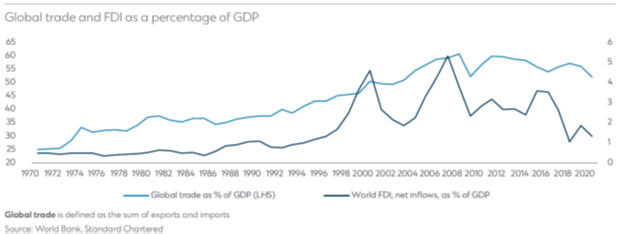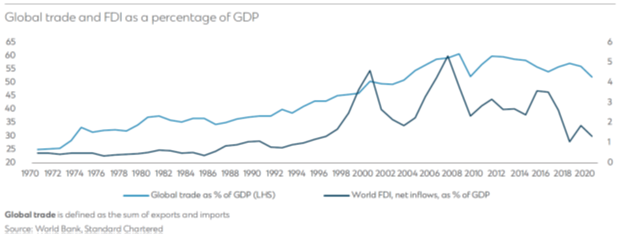

The Fed has been much derided for its 2021 characterisation of the spike in inflation being ‘transitory’ – to the extent that Mohamed El-Erian asked ChatGPT to write a poem about it (well worth a read, by the way!). For the two decades before COVID, the Fed’s main concern had been its inability to create enough inflation, which resulted in the famous Greenspan and Bernanke puts – whereby the Fed eased monetary policy significantly whenever markets hinted at a potential downturn in economic activity.
This leads us to the natural question, what comes next? In the immediate future, inflation looks most likely to recede. Indeed, the key question for the near-term outlook appears to be how quickly inflation will decline and what the Fed’s reaction function will be, should the economy weaken significantly while inflation is still above its inflation target (which is our central scenario).
Arguably more important for investors, however, is the longer-term outlook for inflation. Will we return to the ‘old normal’ of ‘lowflation’ and central bank puts? Or is this a ‘new normal’ whereby fighting inflation is going to be the Fed’s predominant concern? We believe that a return to the old ‘lowflation’ environment is the least likely outcome. There are three key factors driving this view.
One of the main drivers of ‘lowflation’ was the acceleration of globalisation following the initiation of diplomatic ties between the US and China in the 1970s, the collapse of the Berlin Wall in 1989 and China’s accession to the World Trade Organisation in 2001. These three events unleashed a huge wave of disinflationary pressures as companies focused on redirecting investment and production aimed at increasing cost efficiency. This trend is best evidenced by the rise in the trade intensity of global economic activity (see chart below).
However, there are signs that this ‘peace dividend’ is starting to unwind. While total trade has not fallen, the trade intensity of GDP has started to decline. Meanwhile, there is increasing anecdotal evidence even the trade that is taking place is factoring in geopolitical risks. This is leading to ‘friendshoring’ or ‘nearshoring’. While this is presumably a better economic outcome than onshoring, as it still harnesses comparative advantages to some extent, the benefits are likely to be significantly lower than a more purely globalised world. With no signs that these trends are going to reverse in the near term, this is likely to mean inflation is likely to be higher than it has been over the past three decades.

The second factor that is likely to drive inflation higher is the drive to become carbon neutral. While there are good reasons to believe that the increased cost for greener sources of energy and production processes will diminish over time, they are unlikely to disappear. Meanwhile, the scale of infrastructure investment required to achieve the net zero targets is incredible, and this is likely to put upward pressure on the prices of all sorts of raw materials and inputs.
The final potential driver of higher inflation is the world’s aging demographics. Urbanisation, the prevalence of the internet and more access to education are driving fertility rates lower around the globe. This will reduce the size of the global workforce and likely give workers increased bargaining power, as opposed to the declining share of the spoils of capitalism for workers that has been the trend over the past 30 years. If this scenario plays out, higher wages will likely put upward pressure on inflation.

Therefore, while the trend for 2023, and maybe into early 2024, is likely to be for inflation to fall back towards central bank targets, we believe the next decade and beyond is likely to be characterised by upside risks to inflation. This has significant implications for how central banks will be managing monetary policies. The vast majority of my career has been in an environment when central banks have been focused on avoiding a debt-deflation spiral. Going forward, it is likely to revert to an environment where it is more alert to the upside risks to inflation and less willing to come to the market’s rescue every time there is a risk-off environment.